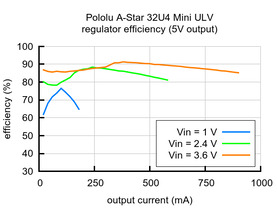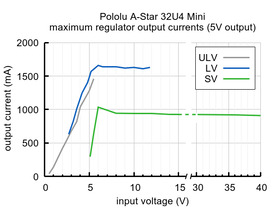
A-Star 32U4 Mini ULV
All prices are VAT included
The A-Star 32U4 Mini ULV is a programmable module based on the ATmega32U4 from Microchip (formerly Atmel). Unlike competing products, it has an on-board switching step-up regulator that allows it to be powered efficiently from a 0.5 V to 5.5 V supply. This compact 1.9″ × 0.7″ board breaks out all 26 of the microcontroller's I/O pins (of which 7 can be used as PWM outputs and 12 as analog inputs), and loading programs is made easier by a Micro-USB interface and a preloaded Arduino-compatible bootloader.
Overview
The Pololu A-Star 32U4 Mini boards are general-purpose programmable modules based on the ATmega32U4 AVR microcontroller from Microchip (formerly Atmel), which has 32 KB of flash program memory, 2.5 KB of RAM, and built-in USB functionality. The A-Star (abbreviated A*) adds a number of onboard features to support the microcontroller and make it easier to work with, including a 16 MHz crystal, a USB Micro-B connector, an in-system programming (ISP) header, a reset button, and three indicator LEDs.

|
A-Star 32U4 Mini ULV, LV, and SV. |
|---|
Each A-Star 32U4 Mini contains a switching regulator that efficiently produces 5 V from an external voltage source to power the microcontroller. Three different versions are available, covering a wide range of input voltages:
- A-Star 32U4 Mini ULV : 0.5 V to 5.5 V
- A-Star 32U4 Mini LV : 2.7 V to 11.8 V
- A-Star 32U4 Mini SV : 5 V to 40 V
A robust power selection circuit enables seamless transitions between regulator power and USB power, and overcurrent and reverse-voltage protection help safeguard the board against accidental damage.
All 26 general-purpose I/O lines on the ATmega32U4 are accessible on the A* 32U4 Mini; 7 of these are usable as PWM outputs and 12 are usable as analog inputs. The board measures 1.9″ × 0.7″, the same size as an Arduino Micro , and features a pair of mounting holes sized for #2 or M2 screws (not included). Its 0.1″ pin spacing makes the A* easy to use with solderless breadboards , perfboards, and 0.1″-pitch connectors .
Our comprehensive user's guide provides the basics you need to get started with the A-Star as well as detailed technical information for advanced users.
This product requires a USB A to Micro-B cable (not included) to connect to a computer.
Features
- Dimensions: 1.9″ × 0.7″ (1.95″ × 0.7″ including USB Micro-B connector)
- Programmable 16 MHz ATmega32U4 AVR microcontroller
- 32 KB flash (4 KB used by bootloader, leaving 28 KB available for user program by default)
- 2.5KB SRAM
- 1KB EEPROM
- Native full-speed USB (12 Mbps)
- Preloaded with Arduino-compatible bootloader (no external programmer required)
- All I/O lines from the ATmega32U4 broken out in a compact package
- 26 general-purpose I/O pins available along the sides of the board
- 7 pins can be configured as hardware PWM outputs
- 12 pins can be configured as analog inputs
- 3 user-controllable LEDs
- Reset button
- Can be powered from USB or from an external source:
- ULV: 0.5V to 5.5V
- LV: 2.7V to 11.8V
- SV: 5V to 40V
- Switching regulator enables efficient operation
- Power selection circuit allows for seamless switching between power sources and provides overcurrent protection
- Reverse-voltage protection on external power inputs
- Precision 16 MHz crystal
- 6-pin ISP header for use with an external programmer
- Comprehensive user's guide
Details for item #3102
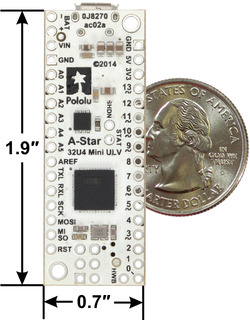
|
A-Star 32U4 Mini ULV, bottom view with dimensions. |
|---|
This version, the A-Star Mini ULV , can be powered from a 0.5 V to 5.5 V external source. The input voltage is regulated to 5 V by a TPS61202 switching step-up (boost) converter from Texas Instruments. (We also make a standalone regulator based on this integrated circuit.)
The regulator's low minimum input voltage makes it possible to power this A* with 1 to 3 NiMH, NiCd, or alkaline cells or from a single lithium cell. Unlike standard boost regulators, the TPS61202 also features a linear down-regulation mode that is automatically enabled when the input voltage exceeds 5 V, allowing it to handle input voltages as high as 5.5 V.
As shown in the left graph below, the ULV's switching regulator has an efficiency – defined as (Power out)/(Power in) – of 70% to 90% for most combinations of input voltage and load.
|
|
The A-Star's components, including the microcontroller and LEDs, draw 30 mA to 40 mA in typical applications. The rest of the regulator's achievable output current, which depends on input voltage as well as ambient conditions, can be used to power other devices. The right graph above shows output currents at which the voltage regulator's over-temperature protection typically kicks in after a few seconds. These currents represent the limit of the regulator's capability and cannot be sustained for long periods; a good estimate for the maximum continuous regulator output current is 60% to 70% of the values shown in the graph.
Arduino compatibility
The A-Star 32U4 ships with a preloaded Arduino-compatible bootloader (which uses 4 KB of flash memory, leaving 28 KB available for the user program). We provide a software add-on that enables the board to be easily programmed from the Arduino environment.
The A-Star 32U4 Mini boards use the same microcontroller as the Arduino Leonardo and Arduino Micro and run at the same frequency, and they are the same size as the Arduino Micro, but they offer a number of advantages over these other ATmega32U4-based boards . Most notably, their efficient switching regulators cover a wide range of input voltages, opening up new possibilities for powering projects built around Arduino-compatible microcontroller boards. Another advantage is the power selection circuit based on the TPS2113A power multiplexer from Texas Instruments, which allows safe, seamless power switching between USB and an external source without losses from passive components like fuses or diodes along with the ability to monitor and control the selected power source. Additionally, the A* 32U4 Mini breaks out a few additional pins from the ATmega32U4 microcontroller that are not exposed on the Arduino Micro or Leonardo, and it features larger, more convenient mounting holes than the Arduino Micro.
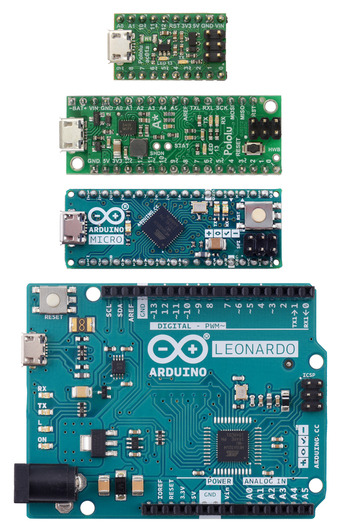 |
Pololu A-Star 32U4 Micro, Pololu A-Star 32U4 Mini SV, Arduino Micro, and Arduino Leonardo. |
|---|
Pinout
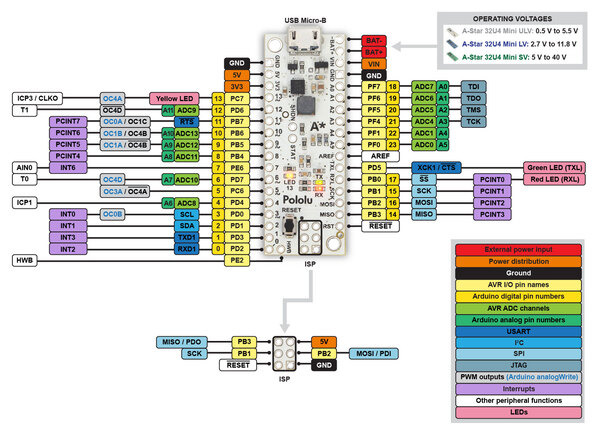
|
This diagram identifies the I/O and power pins on the A-Star 32U4 Mini (even though it shows the ULV version, it applies to all three A-Star Mini boards); it is also available as a printable PDF (269k pdf). For more information about the ATmega32U4 microcontroller and its peripherals, see Microchip's ATmega32U4 documentation .
Printed on the A* circuit board are indicators that you can use to quickly identify each pin's capabilities: a triangle next to the pin means it can be used as an analog input, and a square wave symbol under the pin number means it can be used as a PWM output.
The A-Star 32U4 Mini can either be powered directly from the USB 5 V supply or from an external voltage source, which is regulated to 5 V by its onboard regulator, and the board's power selection circuit enables automatic, uninterrupted transitions between the two power sources. When the A-Star is powered through an external power supply connected to the BAT+ and BAT- pins, its reverse-voltage protection circuit helps prevent it from being damaged by accidentally-reversed power connections, and the VIN pin can be used as an output to supply reverse-protected power to other devices. Alternatively, the external supply can be connected directly between VIN and GND, bypassing the reverse-voltage protection.
The A-Star 32U4 user's guide discusses the board's features in more detail.
Included hardware
A pair of 1×17-pin breakaway 0.1″ male headers is included with the A-Star 32U4 Micro, which can be soldered in to use the board with perfboards, breadboards , or 0.1″ female connectors . Also included is a 2×3 header that can be installed to allow external programming of the microcontroller through the AVR ISP interface, such as with our USB AVR programmer . The board has two mounting holes that work with #2 and M2 screws (not included).
|
|
The A-Star family

|
From top to bottom: A-Star 328PB Micro, 32U4 Micro, 32U4 Mini SV, and 32U4 Prime SV. |
|---|
The A-Star 32U4 Micro is a part of our larger A-Star family , all of whose members are based on AVR microcontrollers and are preloaded with Arduino-compatible bootloaders. The table below shows some key features and specifications of our A-Star microcontroller boards to help you choose the right one for your application.
 |

|
  
|
 
|
 
|
|
|---|---|---|---|---|---|
| A-Star 328PB Micro | A-Star 32U4 Micro |
A-Star 32U4 Mini ULV A-Star 32U4 Mini LV A-Star 32U4 Mini SV |
A-Star 32U4 Prime LV A-Star 32U4 Prime SV |
A-Star 32U4 Robot Controller LV A-Star 32U4 Robot Controller SV |
|
| Microcontrollers: | ATmega328PB | ATmega32U4 | |||
| User I/O lines: | 24 | 18 | 26 | 26 (1) | 26 (1) |
| Available PWM outputs: | 9 | 6 | 7 | 7 | 7 (1) |
| Analog inputs: | 8 | 8 | 12 | 12 | 12 (1) |
| Ground access points: | 6 | 2 | 4 | 43 | 44 |
| User LEDs: | 1 | 2 | 3 | 3 | 3 |
| User pushbuttons: | — | — | — | 3 | 3 |
| USB interface: |  |
 |
 |
 |
|
| Reset button: |  |
 |
 |
 |
|
| Power switches: |  |
 |
|||
| Buzzer option: |  |
 |
|||
| microSD option: |  |
||||
| LCD options: |  |
||||
| Motor drivers: |  |
||||
| Operating voltage: |
3.3V VCC: 3.8 V to 15 V 5V VCC: 5.5 V to 15 V |
5.5V to 15V |
ULV: 0.5V to 5.5V LV: 2.7V to 11.8V SV: 5V to 40V |
LV: 2V to 16V SV: 5V to 36V |
LV: 2.7V to 11V SV: 5.5V to 36V |
| Regulator type: | 3.3 V or 5 V linear | 5V linear | 5V switching ULV: step-up LV: step-up/step-down SV: step down |
5V switching LV: step-up/step-down SV: step down |
5V switching LV: step-up/step-down SV: step down |
| Regulated current: (2) | 100 mA | 100 mA |
ULV: 500mA LV: 1 A SV: 800 mA |
LV: 1.8A SV: 1 A |
LV: 1 A SV: 1.5A |
| Dimensions: | 1.3″ × 0.7″ | 1″ × 0.6″ | 1.9″ × 0.7″ | 2.8″ × 2.1″ | 2.6″ × 2.2″ |
| Weight: | 1.5g (3) | 1.3g (3) | 3.4g (3) | 13g to 33g | 14g to 23g |
| Price: | $8.95 | $16.95 | $24.95 to $24.95 | $24.95 to $39.95 | $29.95 to $39.95 |
| 1 Some microcontroller resources are used by on-board hardware. | |||||
| 2 These values are rough approximations for comparison purposes. Available current depends on input voltage, current consumed by the board, ambient conditions, and regulator topology. See product documentation and performance graphs for details. | |||||
| 3 Without included optional headers. | |||||










